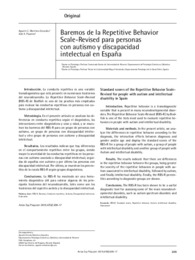Please use this identifier to cite or link to this item:
https://hdl.handle.net/11000/36026Full metadata record
| DC Field | Value | Language |
|---|---|---|
| dc.contributor.author | MARTINEZ-GONZALEZ, AGUSTIN ERNESTO | - |
| dc.contributor.author | Piqueras, Jose A | - |
| dc.contributor.other | Departamentos de la UMH::Psicología de la Salud | es_ES |
| dc.date.accessioned | 2025-03-20T13:25:51Z | - |
| dc.date.available | 2025-03-20T13:25:51Z | - |
| dc.date.created | 2019 | - |
| dc.identifier.citation | Actas Españolas de Psiquiatría. 2019, 47(6): 209-217 | es_ES |
| dc.identifier.issn | 1578-2735 | - |
| dc.identifier.issn | 1139-9287 | - |
| dc.identifier.uri | https://hdl.handle.net/11000/36026 | - |
| dc.description.abstract | Introducción. La conducta repetitiva es una variable transdiagnóstica que está presente en numerosos trastornos del neurodesarrollo. La Repetitive Behavior Scale-Revised (RBS-R) de Bodfish es una de las pruebas más empleadas para evaluar las conductas repetitivas en personas con autismo y discapacidad intelectual. Metodología. En el presente artículo se analizan las diferencias en conducta repetitiva según el diagnóstico, las interacciones entre diagnósticos y sexo y edad, y se muestran los baremos del RBS-R para un grupo de personas con autismo, un grupo de personas con discapacidad intelectual y otro grupo de personas con autismo y discapacidad intelectual. Resultados. Los resultados indican que hay diferencias en el comportamiento repetitivo entre los grupos, siendo mayor la severidad de las conductas repetitivas en las personas con autismo asociado a discapacidad intelectual, seguidas de aquellas con autismo y por último las personas con discapacidad intelectual. Por último, se muestran los percentiles de la escala RBS-R según grupos diagnósticos. Conclusiones. La RBS-R ha mostrado ser una herramienta diagnóstica útil para valorar algunos de los principales trastornos del neurodesarrollo, tales como son los trastornos del espectro autista y la discapacidad intelectual. | es_ES |
| dc.description.abstract | Introduction. Repetitive behavior is a transdiagnostic variable that is present in many neurodevelopmental disorders. The Repetitive Behavior Scale-Revised (RBS-R) by Bodfish is one of the tests most used to evaluate repetitive behaviors in people with autism and intellectual disability. Materials and methods. In the present article, we analyze the differences in repetitive behavior according to the diagnosis, the interaction effects between diagnoses and gender and/or age and display the standard scores of the RBS-R for a group of people with autism, a group of people with intellectual disability and another group of people with Autism and intellectual disability. Results. The results indicate that there are differences in the repetitive behavior between the groups, being greater the severity of the repetitive behaviors in people with autism associated to intellectual disability, followed by autism, and finally intellectual disability. Finally, the RBS-R percentiles according to diagnostic groups are shown. Conclusions. The RBS-R has been shown to be a useful diagnostic tool for assessing some of the main neurodevelopmental disorders, such as autism spectrum disorders and intellectual disability. | es_ES |
| dc.format | application/pdf | es_ES |
| dc.format.extent | 9 | es_ES |
| dc.language.iso | spa | es_ES |
| dc.publisher | Fundación Juan José López-Ibor | es_ES |
| dc.rights | info:eu-repo/semantics/openAccess | es_ES |
| dc.rights | Attribution-NonCommercial-NoDerivatives 4.0 Internacional | * |
| dc.rights.uri | http://creativecommons.org/licenses/by-nc-nd/4.0/ | * |
| dc.subject.other | CDU::1 - Filosofía y psicología::159.9 - Psicología | es_ES |
| dc.title | Baremos de la Repetitive Behavior Scale-Revised para personas con autismo y discapacidad intelectual en España | es_ES |
| dc.title.alternative | Standard scores of the Repetitive Behavior ScaleRevised for people with autism and intellectual disability in Spain | es_ES |
| dc.type | info:eu-repo/semantics/article | es_ES |

View/Open:
2019_102_Investigacion_Publicaciones_Baremos de la Repetitive Behavior.pdf
84,15 kB
Adobe PDF
Share:
.png)
